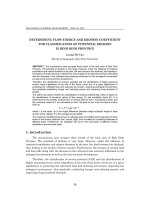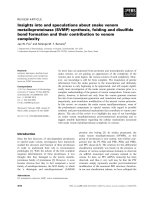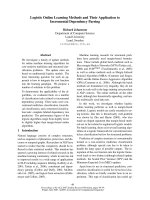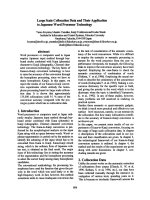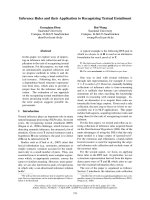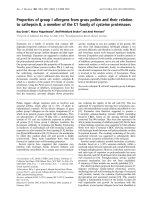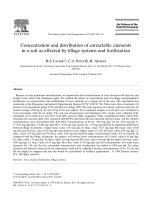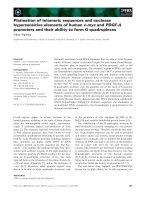Diversity and distribution of corticolous lichens and their relationship to levels of nitrogen dioxide in chiang mai province thailand
Bạn đang xem bản rút gọn của tài liệu. Xem và tải ngay bản đầy đủ của tài liệu tại đây (2.97 MB, 78 trang )
THAI NGUYEN UNIVERSITY
UNIVERSITY OF AGRICULTURE AND FORESTRY
FRANCINA MAE A. BALIDO
DIVERSITY AND DISTRIBUTION OF CORTICOLOUS LICHENS
AND THEIR RELATIONSHIP TO LEVELS OF NITROGEN DIOXIDE IN
CHIANG MAI PROVINCE, THAILAND
BACHELOR THESIS
Study Mode:
Full-time
Major:
Environmental Science and Management
Faculty:
Advanced Education Program
Batch:
K46
Thai Nguyen, 15/11/2018
i
DOCUMENTATION PAGE WITH ABSTRACT
Thai Nguyen University of Agriculture and Forestry
Degree Program
Bachelor of Environmental Science and Management
Student Name
Francina Mae A. Balido
Student ID
DTN1434290109
Thesis Title
Diversity and Distribution of Corticolous Lichens
And Their Relationship to Levels of Nitrogen Dioxide
in Chiang Mai Province, Thailand
Supervisor(s)
1. Asst. Prof Dr. Wanaruk Saipunkaew (Thailand)
2. Dr. Ho Ngoc Son (Vietnam)
Supervisor’s
signatures
Abstract
The study aimed to investigate the diversity and distribution of lichens and
their relationship to levels of nitrogen dioxide within the basin of Chiang Mai
Province. The study evaluated six districts which were Mae Tang, Mae Rim, Doi
Saket, Mae On, San Pa Tong and Chiang Mai City .10 mango trees (Mangifera indica
L.) were selected for lichen investigation in sites. A total of 14 families, 22 genera
and 38 species were found. Thirty- eight species consists of 24 crustose lichens and
14 foliose lichens. The richness and diversity of lichens were determined by using
Shannon Diversity Index. The highest diversity index was found in Mae Tang and
the lowest diversity index recorded was in Chiang Mai City. The highest richness
was both discovered in Mae Tang and Mae On and the lowest richness was found in
Doi Saket. Bray-Curtis Similarity Index was used to determine the similarity of
lichens communities and the distribution of lichens among sites was illustrated by
using Detrended Correspondence Analysis (DCA). The results indicated two main
groups within the six study sites and 30 % similarity were found between the groups.
Lichens species such as Pyxine cocoes, Hyperphyscia adglutinata, Phyllopeltula cf.
corticola, Rinodina roboris and Dirinaria picta were found in urban and suburban
areas. Pyxine cocoes, Hyperphyscia adglutinata and Phyllopeltula cf. corticola were
identified as tolerant species to air pollution. Dirinaria picta was identified as
sensitive species on air pollution. The lowest NO2 concentration (9.5 ppbv) was
distinguished in Mae On and highest concentrations (19.1 ppbv) were found in Mae
Tang, Doi Saket, San Pa Tong and Chiang Mai City. Pearson’s correlation coefficient
was used to correlate all factors and lichen diversity, whereas the results showed that
there is no significant correlation between nitrogen dioxide, environmental factors,
species richness and lichen diversity in the study.
Keywords: lichen diversity, lichen distribution, NO2 concentrations, passive
sampler
i
Number of pages
67 pages
Date of
submission
15/11/2018
ii
ACKNOWLEDGEMENT
My sincerest thanks to my thesis supervisors, Dr. Wanaruk Saipunkaew and
Dr. Ho Ngoc Son for the kind supervision and guidance which both helped me to
do my thesis at my best. In particular, I want to give thanks to Dr. Wanaruk
Saipunkaew for giving me opportunity to worked on my thesis topic “DIVERSITY
AND DISTRIBUTION OF CORTICOLOUS LICHENS AND THEIR
RELATIONSHIP TO LEVELS OF NITROGEN DIOXIDE IN CHIANG MAI
PROVINCE “that I can never finished without the help of my laboratory members
which were MS. Student, Sujinda Bungwan, Ph D. students, Nattakarn
Sransupphasirigul and Chitsupang, Kheawsalab. Jiraporn Saenthiya for the help in
collecting, and identifying lichen specimens. My appreciation also extends for,
MS. Student View Varaphan for assistance in using pH meter and for Dr. Sompron
Chantara for approval of using passive samplers on her laboratory and for the
assistance of her laboratory students that were MS. Student Sukanya Prawan, MS.
Student Patcharee Saejiw and MS. Student Tantaraporn Charoen in preparing and
using the passive samplers. I also want to acknowledge the Head of the Faculty of
Science, Dr. Chitchol Phalaraksh for the appreciation of our work in our research
in Chiang Mai University. I want express my gratitude to Thai Nguyen University,
Chiang Mai University, ASEAN International Mobility of Student (AIMS) for the
opportunity and support for their students on this internship. I would like to express
my gratitude Dr. Ho Ngoc Son for choosing me as one of the students he would
like to handle. And I want specifically to convey my thanks for his motivation and
iii
encouragement to do well even in making my bachelor thesis even before and after
the conduction of data.
My sincerest gratitude to my family and relatives for the endless and
genuine support and understanding on my decisions within the span of living
abroad for studying and making thesis. For that, I become more confident and
matured than before. The blessings and challenges I faced were all worth it with
these people all behind my back and will strive to do better in the future. I also
want to acknowledge my school “Refiners Christian School” which I studied for 9
years and gave me the chance to study abroad which was I am not expecting to do
so and to our Administrator,Mr. Marjun Macaleng, Mrs. Irene Macaleng, School
Principal Mrs. Cherry Tanyag and Ms. Elsa Belen for their encouragement for us
students to venture to this opportunity and be equipped students. I want to convey
my gratitude to my longtime friends which are both in the Philippines and close
friends studying with me which were in Thai Nguyen University for being there
and being each other support and strength whenever I am in good situation and in
a bad situation. I want to specially express my thanks to Kristina Reyes, my
roommate which is a close friend that is very helpful and gave advices whenever I
had worries and Veatriz Malitic for the understanding me and for sharing same
interests with me especially in music. Joy Ongkiatco for being such a honest and
caring friend to me, Enzo Bernardo and Luis Chavez for being such good friend to
me since before until now that proves whenever we understand each other in
worrying times. Jessica Cosico, Aj De Castro, Lester Lagansua, Ghia Sarmiento
and King Reyes which were comfortable friends that I can joke and play with and
iv
same goes for the laughter you had brought to me and to other as well. My Ate’s
and Kuya’s from other batch for looking after me and us younger Filipinos and
gave advices whenever it is about academics and in life situations.
My Vietnamese friends which were I am thankful were Chi Ha Trang, Chi
Qunyh Trang, Chi Luyen Nguyen, Chi Minchau Nguyen Chi Duong Hoàng and
all the Chi and Anh in K46B class who were like my older sisters and brothers that
treats me well. My special thanks also to Pi Puangpech Pongpa for the friendliness
and generosity of your time for me and all of us who are new in Thailand. The
memories of my college journey were about to end and will be forever cherished,
completed and remembered with the friendship that felt already like a family
whenever and I hope to continue for a very long time. I also want to congratulate
myself for holding and giving all the best. You’ve worked hard. And save the best
for last, I want to thank God for everything, the guidance, blessings and challenges
which helped me to grow. You showed me what will happen if I will just follow
you and by that, I entrust and give back all the achievements and experiences I’ve
earned for your own glory.
Student
Balido, Francina Mae A.
v
TABLE OF CONTENTS
LIST OF FIGURES ............................................................................................. viii
LIST OF TABLES ................................................................................................ ix
LIST OF ABBREVIATIONS ................................................................................ x
PART I. INTRODUCTION ................................................................................... 1
1.1
Research rationale .................................................................................. 1
1.2
Research objectives ................................................................................ 3
1.3
Research Questions and Hypotheses ...................................................... 3
1.4
1.3.1 Research Questions ...................................................................... 3
1.3.2 Research Hypothesis .................................................................... 4
Limitations ............................................................................................. 4
1.5
Definitions .............................................................................................. 4
PART II. LITERATURE REVIEW ....................................................................... 5
2.1
Lichens ................................................................................................... 5
2.2
Morphology ............................................................................................ 5
2.3
Growth forms and reproduction ............................................................. 7
2.4
Factors affecting the lichens .................................................................. 9
2.5
Lichens as biomonitors of air pollution .............................................. 10
2.6
Passive Sampling................................................................................. 13
PART III. MATERIALS AND METHODS ........................................................ 17
3.1
Time frame and description of the study areas .................................... 17
3.2
Materials ............................................................................................... 20
3.3
Methods ................................................................................................ 21
3.3.1 Lichens Study .............................................................................. 21
3.3.2 Passive Sampling......................................................................... 23
a) Preparation of the solutions ...................................................... 23
b) Preparation of diffusion tube.................................................... 23
c) Exposure of the diffusion tube ................................................. 24
d) Extraction of the sample........................................................... 25
e) Analysis of the sample ............................................................. 25
3.3.3 Data Analysis ............................................................................... 26
a) Lichens Diversity: Shannon Index ........................................... 26
b) Similarity of lichen communities and distribution of lichens .. 27
c) Correlation between nitrogen dioxide, environmental factors,
species richness and lichens diversity .................................................................. 28
vi
PART IV. RESULTS AND DISCUSSION ......................................................... 29
4.1
Results and Discussion ......................................................................... 29
4.1.1 Lichens Diversity........................................................................ 29
4.1.2 Similarity of lichen communities and distribution of lichens .... 40
4.1.3 Environmental factors in the study sites..................................... 44
4.1.4 NO2 concentration in the study sites .......................................... 45
4.1.5 Correlation between nitrogen dioxide, environmental factors,
species richness and lichens diversity .................................................................. 46
PART V. CONCLUSION AND RECOMMENDATION ................................... 49
5.1
Conclusion ........................................................................................... .49
5.2
Recommendation .................................................................................. 51
REFERENCES ..................................................................................................... 52
APPENDICES ...................................................................................................... 60
vii
LIST OF FIGURES
Figure 1. Three types of lichens (a) crustose (b) foliose (c) fruticose………….8
Figure 2. The process of gas diffusion in the passive sampling procedure…….16
Figure 3. Location of the six selected areas within Chiang Mai Province..........19
Figure 4. The position of a grid frame on selected tree.......................................22
Figure 5. Configuration of passive sampler…………………………..………...24
Figure 6. Analysis of the sample using NO2 test kit…………………………….25
Figure 7. The NO2 standard color chart…………………..………...…………..26
Figure 8. Dendrogram of similarity of lichen communities………………….…42
Figure 9. Distribution of lichens in all study sites…………………………........43
viii
LIST OF TABLES
Table 1. Location of the six study sites. Site number (No.), Study sites, longitude
and latitude and elevation…………………………….…………....................18
Table 2. List of lichens families, genera and species of lichens found in the study
areas…………………………………………………………………………..30
Table 3. List of lichen species and their frequencies in all study areas............34
Table 4. List of richness and diversity index in the study areas………….......39
Table 5. List of environmental factors collected in study sites…………........44
Table 6. List of the NO2 concentrations in study sites……………………......45
Table 7. Pearson correlation coefficient between (r) eight parameters…….....48
ix
LIST OF ABBREVIATIONS
DCA
Detrended correspondence analysis
GF/A
Glass Microfiber filters
GPS
Global Positioning System
H'
Shannon Diversity Index
MVSP
Multivariate Package Program
NO2
Nitrogen dioxide
PM
Particulate matter
ppbv
parts per billion by volume
SO2
Sulphur dioxide
x
PART I. INTRODUCTION
1.1 Research rationale
The economic growth of Thailand causes several issues which has come to
a point where it is negatively affecting its people and environment. Air pollution
is one of the issues that beset the country as it is significantly worsening problem
in recent times. Several health implications concerning on respiratory- related
conditions increased and caused 50, 000 deaths per year (Pacific Prime Thailand,
2017). In which particularly, Chiang Mai Province located in Northern Thailand
greatly showed rapid growth of its economy since the number of tourist attractions,
accommodations, factories, restaurants, road constructions and business buildings
1
have increased as well as the number of tourists visited Chiang Mai Province.
Moreover, the industry and service sectors were considered to be the top two
largest laborers in the province over the past few years (Kitirianglarp, 2015).
By these gains of the economic sector, there were trade-offs observed in the
province, these are the traffic congestion, poor waste management, water and air
pollution which generally affect the natural environment and resources of the
province. And out of these problems, air pollution is the biggest and greatly affects
most of the people in terms of health. According to the Pollution Control
Department, PM 2.5 levels recorded on March 18, 2018 ranged from 48 – 86
micrograms per cubic meter of air which is high compared on the safety level of
50 micrograms per cubic meter of air.
1
Annually, there are many cases wherein the residents and tourists in the
hospital complain some illnesses and even caused several deaths because of the
pollution. These deaths caused by the excessive exposure to hazardous pollutants
such as sulphur dioxide, benzene, lead, carbon monoxide and nitrogen oxide.
Particularly, sulphur dioxide causes shortness of breath, benzene can cause
leukemia (ATDSR, 2007) and lead affects the central nervous system and the brain
(WHO, 2018). On the other hand, too much exposure to carbon monoxide can lead
to death (NCEH, 2017) and respiratory problems when someone intake nitrogen
oxide in extremely high amount (US EPA, 2016).
In general, conception of imposing standard levels of nitrogen dioxide
aimed to protect human health. Pollution Control Department under the Ministry
2
of Natural Sources and Management in Thailand set the standard levels for the
hazardous pollutants in Thailand to compare to the present levels in an hour, month
and a year.
Likewise, other ways of monitoring the air pollution is considered to be
useful and helpful. These ways, for example is using lichens as biomonitoring
method (Blasco et al., 2008) and by the use passive sampler which collects the data
of nitrogen dioxide levels which is physicochemical monitoring method. Both
methods are known and commonly used in determining air pollution as the
biomonitoring method determine the effects of the pollution to organisms and the
physicochemical method identifies the concentration of the hazardous pollutants.
2
1.2 Research objectives
With that, the objectives of the study are to investigate lichens diversity and
their distribution of the lichens within the basin of Chiang Mai Province, to
monitor the environmental factors and nitrogen dioxide levels and to determine the
correlation between nitrogen dioxide, environmental factors, species richness and
lichen diversity.
1.3 Research Questions and Hypotheses
1.3.1 Research Questions
The research questions are based on the objectives of the study which are
the following:
3
1.
What is lichen diversity in Chiang Mai Province?
2.
What is the similarity of the species communities and lichen distribution
within the study sites?
3.
What is the light intensity, temperature, relative humidity, bark pH,
elevation, species richness and nitrogen dioxide levels in each site?
4.
What is the correlation between nitrogen dioxide levels, environmental
factors (light intensity, temperature, relative humidity, elevation and
bark pH), species richness and lichen diversity in Chiang Mai Province?
3
1.3.2 Research Hypothesis
The study comprises two hypotheses such as
1. Null Hypotheses: No significant correlation between nitrogen dioxide
levels, environmental factors, species richness and lichen diversity.
2. Alternative Hypotheses: Significant correlation between nitrogen dioxide
levels, environmental factors, species richness and lichen diversity.
1.4 Limitations
The limitation of the study was the lack amount of time in conducting the
research which results on a short observation on lichens diversity and distribution.
Usage of only capable equipment on producing results within short study period
was considered such as the passive sampler. Passive sampler is known as a simple
4
and easy device on collecting nitrogen dioxide levels.
1.5 Definitions
Lichens – organism made up from the combination of fungi and algae and/or
cyanobacteria.
Passive sampling - physico- chemical method which can access the amount of
pollutants.
Pearson correlation coefficient- statistical measure of the strength of the
association of two variables.
4
PART II. LITERATURE REVIEW
2.1 Lichens
Lichens are composite organisms made up by the symbiotic relationship of
fungus, algae and/or cyanobacteria. The fungus is called mycobiont and algae
and/or cyanobacteria is called photobiont (De Santis, 1999). There are two specific
names for photobiont, it is phycobiont (algal photobiont) and cyanobiont
(cyanobacterial photobiont). The mycobiont provides the structure and protection
while the photobiont supplies food since it has chlorophyll. Therefore, this
composite organism is situated in the Fungi Kingdom as the function of fungus is
associated with overall appearance of the lichen.
The mycobiont components in lichens are from the two groups of fungi
5
which are Ascomycetes (common) and Basidiomycetes (rare) group whereas, the
common photobionts for phycobiont are Trentepohlia and Trebouxia and for
cyanobiont are Stigonema, Nostoc, and Scytonema (Wolseley et al., 2015). Also,
it is a composite organism that is found in many substrates such as soil (terricolous
lichens), bark (corticolous lichens), rocks (saxicolous lichens) and habitats
(mountains, seashores and rainforests) which contributes in some important
process such as the process of slowing down the soil formation and providing food
and shelter for animals.
5
2.2 Morphology
The structure of the lichens is comprised of its body which is made up of
filaments of fungal cells and this lichen body is called thallus (singular thalli). It
has two types based on the internal structure namely homoiomerous thalli that is a
simple type of thallus having only the filaments of fungal cells and algae in it while
heteromerous thalli is a layered type wherein it is composed of four parts. These
parts are the upper cortex, algae layer, medulla and lower cortex (Constantine et
al., 2018).
The upper cortex is the outer and protective layer covering of the thallus
while the algae layer is the photosynthetic area in the thallus and whereas the algae
associates with fungal hyphae. For the medulla, it is the central foundation of the
6
whole structure of thallus having firm walls and capable of acquiring gases in
lichens. The fungal hyphae in the medulla layer is uncompact but on the lower
cortex, it has compacted fungal hyphae (Lepp, 2011b). And whereas some hyphae
from the bottom termed as rhizines serve as roots to stick into subtrates is present
and when the lower cortex is absent in the structure, the hypothallus is formed from
a small sheet of hyphae to do the role.
Alongside with that, there are other structures such as hapter, holdfast
cephalodia, cilia, pruina, cyphellae and pseudocyphellae in lichens. Hapter and
holdfast help lichens attach on subtrates besides rhizines. Cephalodia are small
structures found only when lichen has both cyanobacteria and green algae
(Henskens et al., 2012). These small structures usually in the upper or lower part
6
of the thallus and their important function is to execute nitrogen fixation in the
environment.
Cilia are small hair-like structures and pruina is an icy white coating which
usually obtains calcium oxalate. Both cilia and pruina are found on margin of the
lichens. The cyphellae are pores observed in the lower surface of thallus while the
pseudocyphellae are the tiny pores formed by the expansion of medulla layer on
the lower cortex and it is like a line along the margins on the upper cortex (Lepp,
2011a).
2.3 Growth forms and reproduction
Lichens have three common growth forms which are crustose, foliose and
fruticose (Figure 1). Crustose lichen is the most common growth form and this
7
type of lichen is a crust-like lichen and firmly attached to its substrates while
foliose lichen is the type of lichens that has flattened shapes. It is also known as
leaf-like lichen that loosely binds on its substrate. Fruticose lichen shown in Figure
1 (Sharnoff, 2018) is a shrub like or hair like lichens that grows in substrate by
only attachment of its lower part since it obtains multidimensional forms (Lepp,
2011b). The growth of these crustose, foliose and fruticose lichens per year is
usually around 0.5-5 mm.
7
(a)
(b)
(c)
Figure 1. Three types of lichens (a) crustose (b) foliose (c) fruticose
Reproduction of lichens is done by sexual and asexual (vegetative)
reproduction. In sexual reproduction, only the fungal component is being
reproduced and there are fruiting bodies that have structures which are commonly
known as ascus and basidium. Ascus and basidium structures are particularly like
8
container of spores that are being produced by two fungal partners such as
Ascomycetes and Basiodiomycetes. Ascomycetes produce spores called ascopores
and Basiodiomycetes carried out spores named as basidiospores.
In addition, these fruiting bodies are distinguished by their different forms
namely apothecia and perithecia. Apothecia are cup-like fruiting bodies found in
the upper surface and can be differentiated into three kinds: lecanorine, lecideine,
and lirellae. For lecanorine apothecia, it has algae and margin having the same
color with its thallus. However, there is no margin, algae and have different color
when it is a lecideine apothecia (Smith, 1921). Lirellae apothecia is long in shape
and specifically attain black colored margins. On the other hand, perithecia are
spherical-like fruiting bodies whereas it only has small opening unlike apothecia.
8
Asexual or vegetative reproduction for lichens involves three structures.
These include isidia, soredia and lobules and unlike from the sexual reproduction
both the algal and fungal components are reproduced. Isidia are barrel-shaped or
coral-like structure, soredia are small and powdery group of hyphae and lobules
are flat lobes in the thallus. These structures detached on the thallus and reproduce
by the environmental conditions and physical interactions, for example by wind
and disturbance of animals (Smith, 1921).
2.4 Factors affecting the lichens
Lichens are composite organisms found on variety of habitats where there
are substrate and environmental conditions for their growth. The substrate
9
conditions, for instance are surface types and components. Lichens are generally
having high frequency on rough, flaky and persistence barks and low frequency on
smooth barks. Likewise, for the surface components including the pH value and
water content on the tree barks, lichens can survive even though there is little
amount of water available and has moderate amount of acidity in the substrates
(Lam et al., 2013).
Environmental conditions affecting the lichens were temperature, relative
humidity, light intensity and elevation. Both environments that have high and low
temperature alter the richness of lichens because the reproduction and the food of
lichens are limited by these temperatures. The factor of humidity in general,
influences the lichen growth at which point is more evident in high humid locations
9
than the places that have low humidity (Čabrajić, 2009).The light intensity upon
lichens is also one of environmental conditions considered as the sunlight plays an
important role for lichens to exist. And for that, lichens are present in places that
have enough exposure on sunlight (Lam et al., 2013). The growth and diversity of
lichens is also influenced by elevation, as higher elevation the more diverse and
species of lichens were observed (Kumar et al., 2014).
2.5 Lichens as biomonitor of air pollution
Both sensitivity and adaptive capability of the lichens is considered to be
essential in monitoring environmental problems particularly the air pollution. The
sensitivity of lichens is caused by their structure which has the absence of an outer
layer like epidermis or cuticle and roots. In addition to that, the adaptive capability
10
pertains on the structural variations of lichens depending on the environment it
grows. With that, lichens are exposed and notably influenced by their atmospheric
conditions ascertaining their relevancy as an indicator of air pollution (Lawrey,
2018).
Crustose, foliose and fruticose lichens have their own level of tolerance on
the changes in the environment. Within these lichens, crustose lichens are known
to be the most tolerant lichen species since it is still present even in areas that have
polluted air. Whereas, foliose lichens can only grow in partly polluted areas and
fruticose lichens cannot live totally on places that has really small amount of
pollutants since it requires completely clean air for it to grow (BBC, 2014).
Likewise, the determination of sensitive (absent) and tolerant (present) species
10
within the three common lichens specifically helps in distinguishing the possible
indicator species as well as the changes in the environment.
With that, some studies evaluated the global environmental problem which
is climate change by using the responses of lichens in terms of the diversity and
abundance within the areas of study. As for example, a sixteen –year (1993- 2009)
study in US Pacific Northwest determined that the high elevation lichens were the
most affected since the number of species and the distribution decreased
comparing on the low elevation concluding that the warming greatly affect the
cooler environments (Glavich et al., 2018). A study from North-western Alaska
observed low number of lichens in the Arctic tundra (Joly et al., 2009).
And, a study on cold temperature species of lichens decline in both highland
11
specifically in the mountains of Western and Central Europe and lowland areas
(Shukla et al., 2018). Nevertheless, from some studies lichens were increasing in
cold climates rather than decreasing. A study on forests in Sweden whereas
specific species were investigated lichens such as Bryoria spp., Usnea spp. and
Alectoria sarmentosa (Ach.) Ach. The Usnea spp. and Alectoria sarmentosa
(Ach.) Ach appeared to increase in the areas that have cold temperature than in
warm temperature places while the Bryoria spp. was not present all in both
temperatures (Esseen et al., 2016). Moreover, climate change increased of either
the extreme heat or rainfall, the growth and the diversity of lichens will still be
affected.
Therefore, lichens in local climate scale were considered to be influenced
by the varying levels of microclimatic factors from each environment it grows. In
11
a study situated in Badrinath valley in Western Himalaya, the lichens were
identified to be affected by the temperature, altitude and relative humidity.
Similarly, distribution study of lichens was altered in the White Mountains of
California because of the light intensity (Gupta et. al, 2014).
And in accordance of the sensitivity and tolerance capability of lichens,
these were used to assess a common environmental problem which is air pollution.
Air pollution pertains on the harmful and excessive amount of pollutants released
in the air caused by the intensified human activities. For instance, these activities
were vehicle emissions, power plants, agricultural and industrial activities and
from that, the common pollutants released are sulphur dioxide and nitrogen
dioxide.
12
With that, the possible availability and excessive amount of atmospheric
pollutants such as nitrogen dioxide and sulphur dioxide were monitored by using
lichens (Richardson ,1988). As both high amount of nitrogen dioxide and sulphur
dioxide negatively affect the chlorophyll and eventually kills the lichen. Due to
that, studies about both atmospheric pollutant levels used particularly the sensitive
and tolerant species of lichens on each pollutant.
Based on that, there was a study that discovered new species of lichens and
occurrence again of some species in London conforming the air quality became
free from sulphur dioxide (Hawksworth & McManus, 1989). In United Kingdom,
the nitrogen dioxide pollution was observed as five terricolous alpine lichen
species were affected which were sensitive lichen species to nitrogen dioxide
(Nash & Gries, 2002).
12
A study in Colombo and suburbs that determined the amount of sulphur
dioxide and nitrogen dioxide pollution evaluated lichens as well as the
disturbances found in the area of the study. The pollution within the area was
confirmed to be in high amount since there was a declined in number of lichens as
well as the total absence of tropical lichens. Considering that, these tropical lichens
were generally known as pollution sensitive species in the study in area of
Colombo and suburbs (Attanayaka et al. 2007).
Muhammad et al. (2018) identified the D. picta species of lichens as the
species associated with the vehicular emissions in Malaysia particularly in Bahut
Pahut area. Since, D. picta was present in all locations whether it has high traffic
or low traffic level and considered to be the tolerant lichen species among all the
13
present lichens. Alongside with that, a study in Chiang Mai, Thailand determined
that P. cocoes was tolerant to air pollution. And also determined the sensitivity of
D. picta which may be considered as a bioindicator of air pollution within the area
and the tolerance of P.cocoes (Pimwong, 2002).
2.6 Passive Sampling
The device used in this method is called passive sampler wherein it
performs molecular diffusion to collect the pollutants. In this procedure, there is a
free flow of analytes (heavy metals, inorganic and organic compounds) from the
atmosphere to collecting media illustrated in Figure 2 (sigmaaldrich, 2010). These
compounds can be in any matrices such as soil, water and air (Wongniramaikul,
2012). Furthermore, the average amount from the collected pollutants were
estimated by using the Fick’s law of diffusion.
13
Passive Sampling is a physico- chemical method commonly used in air
pollution monitoring. This method is also considered to be cost- effective and
flexible tool in assessing the amount of pollutants in any study area. It is a costeffective device because it does not require any maintenance for it to work properly
and electricity to operate as the same time as it is a flexible tool by being a
lightweight and simple device.
Due to that, some studies emerged using passive sampling methods in their
respective countries with the purpose of monitoring air pollutants and their amount
which affects the air quality in the country. In Malaysia, the results from the
passive sampling proved the impact of the human activities, specifically the
construction site and vehicle emissions on the air quality in the area. Considering,
14
three areas were chosen and among these, the farthest from the roads and the
construction site showed a 14.0 ppbv which was the lowest amount while the area
that was near to these activities displayed a 23.4 ppbv of nitrogen dioxide amount
and the highest nitrogen dioxide amount recorded was 36. 8 ppbv which were
measured in the areas that was nearest to the activities (Chong et al., 2017). A
monitoring study in the major highways in Abeokuta, Nigeria determined air
pollutants like nitrogen dioxide, sulphur dioxide, carbon dioxide and other
pollutants in both wet and dry seasons. And all the pollutants appeared to be in
high concentration in the dry season than wet season. For instance, the Iyana
Mortuary have the highest concentration of both nitrogen dioxide and sulphur
dioxide. This can be associated with the domestic cooking, expanding of roads and
traffic congestion. Likewise, the high concentration of carbon dioxide in Kuto was
14
